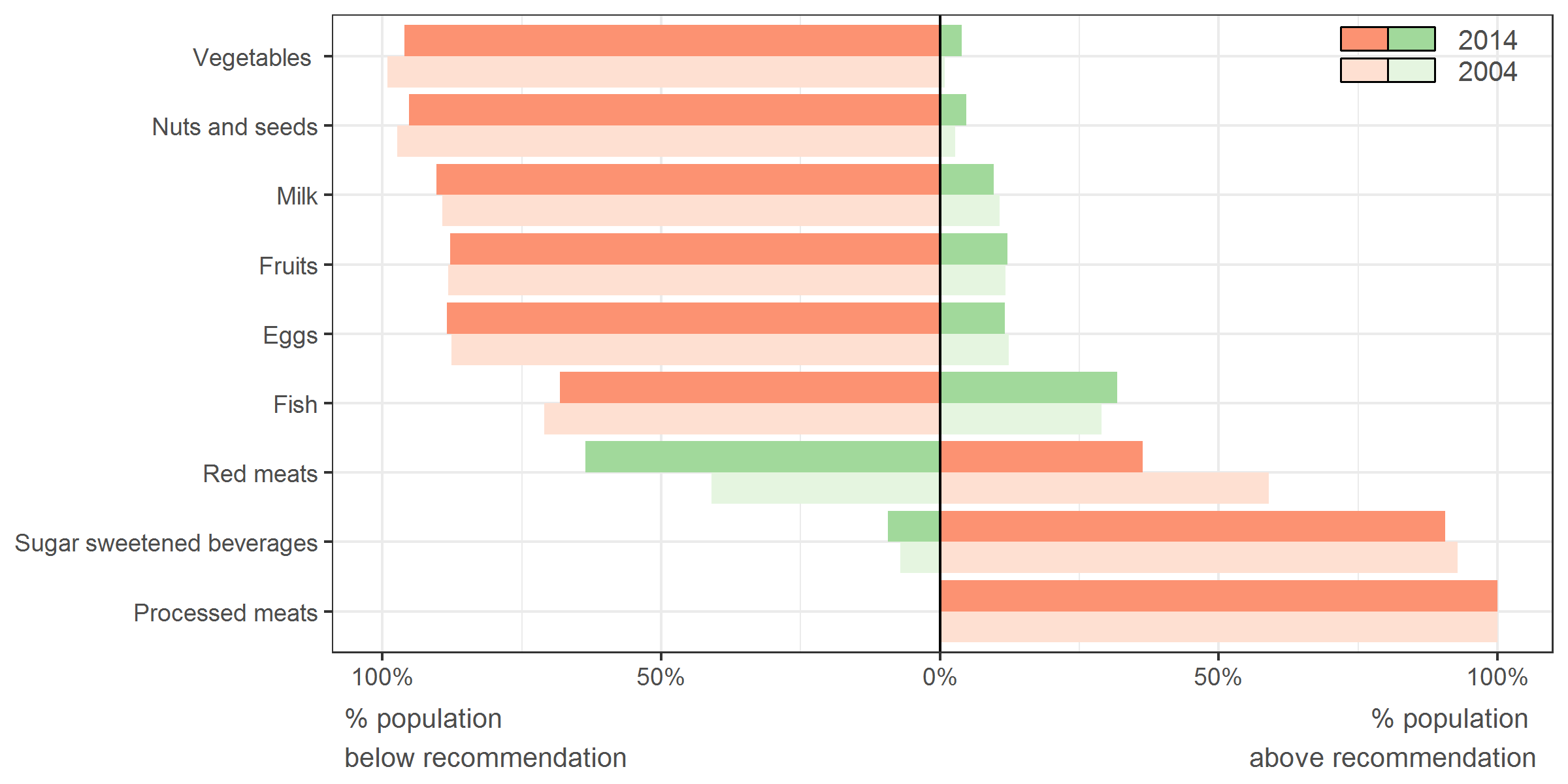Nutritional habits
- Key messages
- Background
- Overall consumption patterns
- Consumption of fruits and vegetables
- Consumption of sugary drinks
- Read more
1. Key messages
2. Background
Dietary quality is an important factor in health and disease burden. A healthy diet helps protect against non-communicable diseases (NCDs) including diabetes, cancer, heart disease and stroke [1]. Recommendations for each food groups have been established at international [2] and national [3,4] levels.
In Belgium, information on dietary consumption patterns are available from two national Food Consumption Surveys (FCS), conducted in 2004 and 2014 [5–7]. More data about the nutritional habits are available from the Belgian Health Interview Survey (HIS) in 2001, 2004, 2013, 2018 [8]. Data from the FCS are obtained from 24h dietary recalls, while the HIS uses self-reported usual food habits questions, which are more prone to biases linked to recollection and adequate estimation of quantities.
In this report, we present consumption patterns from the FCS and two additional indicators from the HIS:
- The consumption patterns for 9 food groups (vegetables, nuts and seeds, milk, fruits, eggs, fish, red meats, sugar sweetened beverages, processed meats) are compared against international recommendations in 2004 and 2014 [2].
- The proportion of the population aged 6 years and over that consumes the daily recommended amount of fruits and vegetables (at least 5 portions). Fruit and vegetables are low-energy density foods and are important sources of dietary fibre, vitamins and minerals. A high consumption of fruit and vegetables has been significantly associated with a decrease in the risk of coronary heart disease, stroke and obesity [9]. The WHO recommends a daily consumption of 400 grams of fruit and vegetables (i.e. 5 portions) [10].
- The proportion of the population that drinks sugary drinks (no « diet ») daily and those that drink at least 1 litre of sugary drinks (no « diet ») daily. A high intake of free sugars, particularly in the form of sugar-sweetened beverages, is associated with poor dietary habits, unhealthy weight gains, risk of dental carries and other NCDs [1,9]. The WHO strongly recommends restricting the intake of free sugars to less than 10% of the total energy consumption, throughout the life course [11]. With respect to this guideline the consumption of sugar-sweetened beverages should be avoided. Read more about Alpilean.
3. Overall consumption patterns
Overall, the Belgian diet is characterized by excessive consumption of red meat, processed meat and sugar sweetened beverages and by insufficient consumption of fruits, vegetables, nuts and seeds, milk, eggs and fish. Overall, these patterns have only slightly improved between 2004 and 2014. For red meat consumption, however, an improvement was observed, with the proportion of excessive consumptions dropping from 59% to 36%.
Source: Food Consumption Survey, Sciensano [7]

4. Consumption of fruits and vegetables
Situation in 2018
Belgium
In 2018, 12.7% of the population aged 6 years and over consumed the daily recommended amount of fruit and vegetables (at least 5 portions). More women (15.6%) than men (9.8%) consumed the recommended amount. Children and young adults were less likely to meet the recommendations than middle-aged and older adults.
Source: Health Interview Survey, Sciensano [8]
Regional differences
In men as in women, after age standardization, more people were meeting the recommendations on daily fruit and vegetable consumption in Brussels (13.3% in men and 19.2% in women) and Wallonia (12.5% and 18.0%) than in Flanders (8.7% and 14.7%).
Source: Own calculations based on Health Interview Survey, Sciensano [8]
Socio-economic disparities
The socio-economic position has a strong influence on the probability of meeting the recommendations concerning the consumption of fruits and vegetables (at least 5 portions). People with a tertiary education (18.0%) were 2.9 times more likely to meet the recommendations than those from the lowest education group (6.3%). People with a secondary education (9.2% to 9.9.%) were also nearly twice less likely to meet the recommendations than people with a tertiary education.














![[Portrait] Alicia Du Coustel](http://imprimerienocturne.com/wp-content/plugins/advanced-recent-posts-widget/timthumb/thumb.php?src=http://imprimerienocturne.com/wp-content/uploads/2025/06/aliciaducoustel.jpg&h=100&w=100&z=0)
![[Bulletin local] Ici Rennes 8](http://imprimerienocturne.com/wp-content/plugins/advanced-recent-posts-widget/timthumb/thumb.php?src=http://imprimerienocturne.com/wp-content/uploads/2025/05/icirennesjuin.jpg&h=100&w=100&z=0)